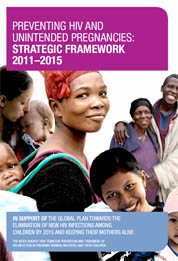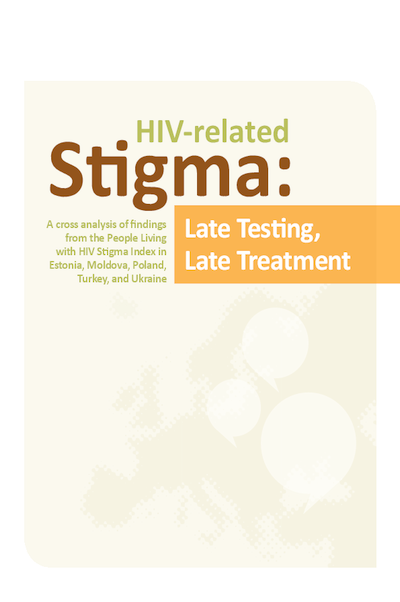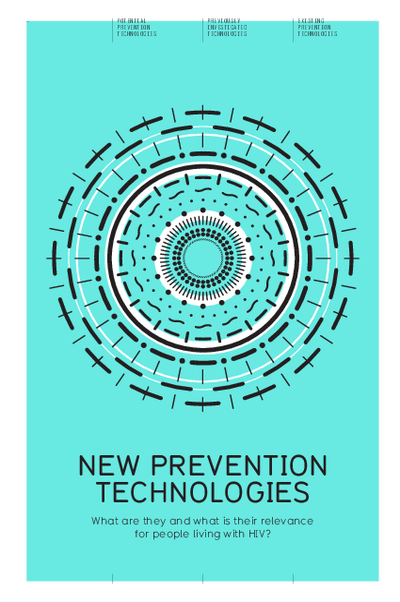
Topic: Treatment and prevention



Community voices: barriers and opportunities for programmes to successfully prevent vertical transmission of HIV identified through consultations among people living with HIV
Abstract
Introduction: In 2010, two global networks of people living with HIV, the International Community of Women Living with HIV (ICW Global) and the Global Network of People living with HIV (GNP+) were invited to review a draft strategic framework for the global scale up of prevention of vertical transmission (PVT) through the primary prevention of HIV and the prevention of unintended pregnancies among women living with HIV. In order to ensure recommendations were based on expressed needs of people living with HIV, GNP+ and ICW Global undertook a consultation amongst people living with HIV which highlighted both facilitators and barriers to prevention services. This commentary summarizes the results of that consultation.
Discussion: The consultation was comprised of an online consultation (moderated chat-forum with 36 participants from 16 countries), an anonymous online e-survey (601 respondents from 58 countries), and focus-group discussions with people living with HIV in Jamaica (27 participants). The consultation highlighted the discrepancies across regions with respect to access to essential packages of PVT services. However, the consultation participants also identified common barriers to access, including a lack of trustworthy sources of information, service providers’ attitudes, and gender-based violence. In addition, participant responses revealed common facilitators of access, including quality counselling on reproductive choices, male involvement, and decentralized services.
Conclusions: The consultation provided some understanding and insight into the participants’ experiences with and recommendations for PVT strategies. Participants agreed that successful, comprehensive PVT programming require greater efforts to both prevent primary HIV infection among young women and girls and, in particular, targeted efforts to ensure that women living with HIV and their partners are supported to avoid unintended pregnancies and to have safe, healthy pregnancies instead. In addition to providing the insights into prevention services discussed above, the consultation served as a valuable example of the meaningful involvement of people living with HIV in programming and implementation to ensure that programs are tailored to individuals’ needs and to circumvent rights abuses within those settings.
Keywords: women living with HIV; people living with HIV; primary prevention; unintended pregnancies; sexual and reproductive health and rights; prevention of vertical transmission
(Published: 11 July 2012)
Citation: Anderson G et al. Journal of the International AIDS Society 2012, 15(Suppl 2):17991
http://www.jiasociety.org/index.php/jias/article/view/17991 | http://dx.doi.org/10.7448/IAS.15.4.17991

There is growing interest in the evidence that antiretroviral therapy (ART) can be used not only as treatment for people living with HIV, but to prevent or reduce transmission of HIV.
This paper focuses on the prevention of sexual transmission from persons living with HIV through the use of ART. The paper focuses on what this means for people living with HIV (at an individual level) and what it means for public health (at the population level).
Informed by a consultation with GNP+’s Board and Secretariat, it articulates conditions needed for treatment as prevention to work effectively while protecting the rights of people living with HIV.

There is growing interest in the evidence that antiretroviral therapy (ART) can be used not only as treatment for people living with HIV, but to prevent or reduce transmission of HIV.
This paper focuses on the prevention of sexual transmission from persons living with HIV through the use of ART. The paper focuses on what this means for people living with HIV (at an individual level) and what it means for public health (at the population level).
Informed by a consultation with GNP+’s Board and Secretariat, it articulates conditions needed for treatment as prevention to work effectively while protecting the rights of people living with HIV.

Some recent studies suggest that women using progestogen-only injectable contraception, such as Depo Provera, may be at higher risk of acquiring or transmitting HIV. The science on the issue, however, is not clear as some studies do not show this relationship.
This brief explores the concerns of people living with HIV around the transmission risks of HIV when using hormonal contraceptives.

This framework supports the ‘Global Plan Towards the Elimination of New HIV Infections among Children by 2015 and Keeping their Mothers Alive’. It is a product of The Inter-agency Task Team (IATT) for Prevention and Treatment of HIV Infection in Pregnant Women, Mothers, and their Children and was developed by the IATT Working Group on Primary Prevention of HIV and the Prevention of Unintended Pregnancies in Women Living with HIV (now included with the Integration Working Group under the re-configured IATT).

This report is a cross analysis of PLHIV Stigma Index data from the research carried out in Estonia, Moldova, Poland, Turkey, and Ukraine, bringing a specific lens to bear on the issues regarding barriers to accessing testing and care. To read a summary presentation of the studies, you can view the presentation below.

To ensure a comprehensive approach to addressing HIV, the international community has been calling for sustained investments and increased efforts towards universal access to prevention, care, treatment and support. This includes significantly improving access to existing proven means of preventing HIV transmission. At the same time, the world needs new prevention tools and technologies that will work with and complement existing prevention methods.
There are a number of global efforts underway to develop new technologies to prevent HIV. Currently, there is research being conducted on vaginal and rectal microbicides, vaccines, pre-exposure prophylaxis (PrEP) and the use of HIV treatment as prevention. Research into NPTs is a lengthy process that takes 12 years or more to go from laboratory and animal testing, to safety and efficacy studies, and through regulatory approval and post-marketing studies.
This toolkit provides a brief definition of each of the potential prevention tools being researched, gives an overview of the current state of research, and discusses their relevance for people living with HIV.
It then outlines research into prevention technologies that have had unsuccessful results—diaphragms and cervical barriers, and treatment for herpes simplex virus type 2 (HSV-2). Finally, the toolkit provides an overview of the prevention technologies that we currently have at our disposal—female and male condoms, medical male circumcision, post-exposure prophylaxis and prevention of vertical transmission (sometimes called prevention of mother-to-child transmission or PMTCT)—and summarises recent findings about these technologies.

This document reports on the findings of an exploratory study on coping strategies and life choices of couples in South Africa, Tanzania and the Ukraine living in long-term serodiscordant relationships – in which one partner is HIV-positive and the other HIV-negative. The primary motivation for doing the study was to inform prevention programmes and global advocacy efforts of GNP+ to promote the health of people living with HIV.
The study was conducted by GNP+, in collaboration with the Centre for Health Policy at the University of the Witwatersrand in Johannesburg, South Africa, and the Human Sciences Research Council (HSRC) in Cape Town, South Africa.
A synopsis was published in the Reproductive Health Matters Magazine nr 37.





This advocacy agenda is a tool for people living with HIV to advocate with other stakeholders in NPTs. It features six key points and is the outcome of the presentations and discussions at the consultation, as well as the working group’s recommendations. It is envisaged that this agenda is a work in progress that will evolve in response to the results of NPT clinical trials currently in progress as well as broader developments in HIV policy as it relates to HIV prevention and people living with HIV.

This report presents the key points and recommendations that emerged during the e-consultation on the forthcoming revision of the WHO’s Recommendations for Antiretroviral Therapy (ART) for HIV Infection in Adults and Adolescents (ART Guidelines), held between July 27th and August 16th, 2009. The e-consultation was organised by the Global Network of People Living with HIV (GNP+) and hosted by NAM. It aimed to gather the perspectives and values of people living with HIV (PLHIV) related to the upcoming revision to the ART Guidelines.

PLHIV see huge benefits in treatment and know that eventually they will need to take ARVs. But in the Asia Pacific region there is some reluctance to start treatment earlier based purely on some practical issues. In starting they want to be assured there will be nothing that will threaten their long term treatment effectiveness related mainly to resistance and the need to rely on second-line regimens which are either not available or not affordable right now. People are also very aware of side effects and their fear of them causes a reluctance to take treatment until it is ‘really necessary’.
They do not believe that guidelines should be compromised by lack of financial and other resources and that the new guidelines should be based on ‘best practice’. If this seems at odds with the first statement, it is because they aspire to optimum treatment but live with the day-to-day practicalities of what is possible, even if it is not optimal

This report presents the key points and recommendations that emerged during the ‘Voting with your feet on antiretroviral treatment’ meeting, a technical consultation on the upcoming revision of the WHO’s Recommendations for Antiretroviral Therapy (ART) for HIV Infection in Adults and Adolescents (ART Guidelines), held 20 July, 2009 during the International AIDS Society Meeting in Cape Town.

This working paper is intended to help build consensus among networks, groups and individuals living with HIV around what positive prevention means and how positive prevention can be better addressed within broader HIV prevention policies and programs. It will review existing conceptions of positive prevention, which have tended to center on the needs of people who are HIV-negative or who are HIV positive but not yet aware of their status, and which have mostly been developed by experts without the involvement of people who know they are living with HIV. This document will propose a different way to think about positive prevention, recommend specific services that should be included in a positive prevention package, and identify areas where further research and/or debate is needed.

